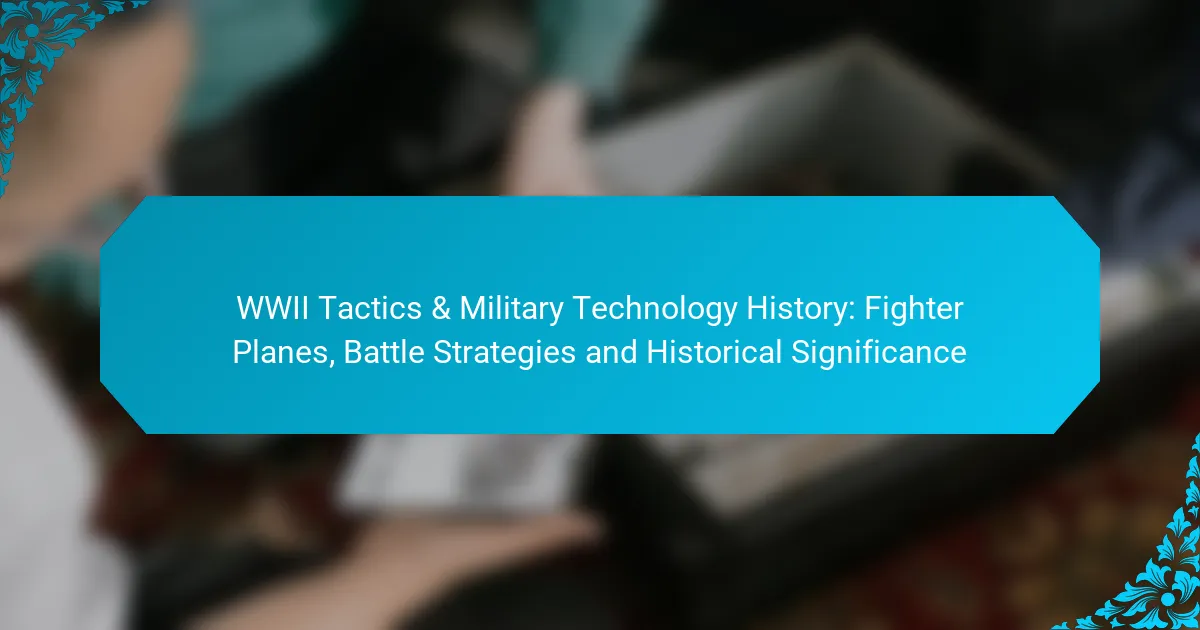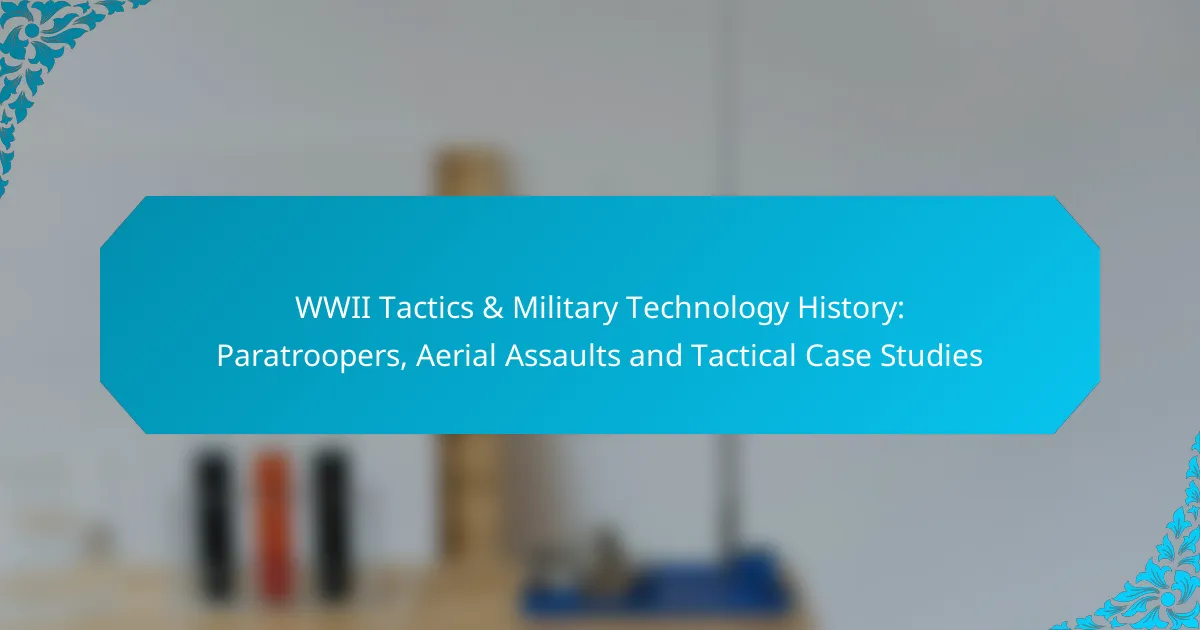World War II marked a pivotal era in military history, characterized by groundbreaking advancements in fighter planes and battle strategies. The development of agile and powerful aircraft was essential for achieving air superiority and executing strategic missions, while innovative tactics emphasized speed and coordination. These technological and strategic evolutions not only influenced the course of the war but also reshaped modern warfare as we know it today.

What Were the Key WWII Fighter Planes?
The key WWII fighter planes played a crucial role in air superiority, ground support, and strategic bombing missions. These aircraft were designed for speed, agility, and firepower, significantly impacting the outcome of battles throughout the war.
P-51 Mustang
The P-51 Mustang was one of the most effective fighter planes of WWII, known for its long range and high speed. It featured a powerful Packard V-1650 engine, allowing it to escort bombers deep into enemy territory and engage in dogfights effectively.
With a top speed of around 440 mph and a service ceiling of 40,000 feet, the Mustang outperformed many of its contemporaries. Its combination of speed, firepower, and range made it a favorite among pilots and a nightmare for enemy forces.
Messerschmitt Bf 109
The Messerschmitt Bf 109 was the backbone of the Luftwaffe and one of the most produced fighter aircraft in history. It was known for its versatility, serving in various roles including interceptor, fighter-bomber, and reconnaissance.
Equipped with a Daimler-Benz DB 601 engine, the Bf 109 could reach speeds of approximately 350 mph. Its design allowed for continuous upgrades throughout the war, maintaining its competitiveness against Allied fighters.
Supermarine Spitfire
The Supermarine Spitfire is renowned for its role in the Battle of Britain, where it helped defend against German air attacks. Its elliptical wings provided excellent maneuverability and speed, making it a formidable opponent in dogfights.
With a top speed of around 360 mph and a range of about 500 miles, the Spitfire was equipped with eight .303 Browning machine guns, delivering significant firepower. Its iconic design and performance have made it a symbol of British resilience during the war.
Focke-Wulf Fw 190
The Focke-Wulf Fw 190 was a German fighter that combined speed, firepower, and ruggedness. It was initially designed as a fighter-bomber but quickly proved its worth as a dedicated air superiority fighter.
Powered by a BMW 801 radial engine, the Fw 190 could reach speeds of up to 400 mph. Its heavy armament, which included 2 cm cannons and machine guns, made it effective against both bombers and enemy fighters.
Lockheed P-38 Lightning
The Lockheed P-38 Lightning was unique for its twin-engine design and distinctive twin-boom structure. It excelled in high-altitude missions and was used for long-range escort and ground attack roles.
With a top speed of around 400 mph and a range exceeding 1,000 miles, the P-38 was equipped with four .50 caliber machine guns and a 20 mm cannon, providing a powerful punch. Its versatility and performance made it a key asset in the Pacific and European theaters.

How Did WWII Battle Strategies Evolve?
World War II saw significant evolution in battle strategies, primarily driven by technological advancements and the need for rapid, decisive victories. Key strategies emerged that emphasized speed, coordination, and the effective use of combined arms to achieve military objectives.
Blitzkrieg Tactics
Blitzkrieg, or “lightning war,” was a military strategy employed by Germany that focused on swift, coordinated attacks using infantry, tanks, and air support. This approach aimed to break through enemy lines quickly, disrupting communications and supply routes to create chaos and panic.
Effective Blitzkrieg operations often involved concentrated assaults on weak points, followed by rapid exploitation of breakthroughs. The use of mechanized units allowed for mobility and flexibility, enabling forces to encircle and isolate enemy troops. Key examples include the invasions of Poland and France, where speed and surprise led to quick victories.
Island Hopping Strategy
The Island Hopping strategy was primarily used by Allied forces in the Pacific Theater to capture strategically important islands while bypassing heavily fortified ones. This approach allowed the Allies to establish bases closer to Japan, facilitating air and naval operations.
By focusing on key islands, such as Guadalcanal and Iwo Jima, the Allies could cut off Japanese supply lines and weaken their overall military presence. This strategy emphasized the importance of logistics and air superiority, as control of the skies was crucial for successful landings and troop movements.
Combined Arms Operations
Combined Arms Operations involve the integration of different military branches—such as infantry, armor, and air support—to achieve a cohesive fighting force. This strategy allows for the strengths of each branch to complement one another, enhancing overall effectiveness on the battlefield.
For instance, during the Normandy invasion, Allied forces effectively coordinated air strikes to soften enemy defenses before landing troops and tanks. Successful combined arms operations require meticulous planning and communication to ensure that all units work in unison, maximizing their impact while minimizing vulnerabilities.

What Were the Technological Innovations in WWII?
World War II saw significant technological innovations that transformed military tactics and capabilities. Key advancements included radar technology, jet engines, and aircraft carriers, each playing a crucial role in shaping the outcome of battles and the overall war effort.
Radar Technology
Radar technology revolutionized military strategy during WWII by enabling forces to detect enemy aircraft and ships at considerable distances. This early warning system allowed for timely responses and improved defensive measures, significantly enhancing air and naval operations.
By the war’s end, radar systems had evolved to include various frequencies and applications, such as ground-based and airborne radar. The ability to track enemy movements in real-time provided a tactical advantage that was previously unattainable.
Jet Engines
The introduction of jet engines marked a pivotal shift in aviation during WWII, leading to faster and more powerful fighter planes. Jet propulsion allowed aircraft to reach higher speeds and altitudes, fundamentally changing air combat dynamics.
Notable examples include the German Messerschmitt Me 262 and the British Gloster Meteor, which showcased the potential of jet technology. These advancements laid the groundwork for post-war aviation developments and set the stage for the modern air force.
Aircraft Carriers
Aircraft carriers became essential naval assets during WWII, serving as mobile air bases that extended the reach of naval power. They allowed for the deployment of fighter planes and bombers far from shore, enabling strategic strikes and reconnaissance missions.
The Battle of Midway exemplified the significance of aircraft carriers, as they played a decisive role in the defeat of Japanese forces. The shift from battleship-centric fleets to carrier-based operations highlighted the changing nature of naval warfare and influenced future military strategies.

How Did WWII Impact Modern Military Tactics?
World War II fundamentally reshaped modern military tactics by emphasizing the importance of combined arms operations, mobility, and air superiority. The lessons learned during this conflict continue to influence military strategies and technologies used today.
Lessons from WWII
One of the key lessons from WWII is the effectiveness of coordination between different branches of the military. The integration of infantry, armor, and air support allowed for more dynamic and flexible combat operations. This approach led to the development of joint task forces that are now standard in modern military engagements.
Another significant takeaway is the importance of intelligence and reconnaissance. The use of aerial surveillance and intelligence gathering during WWII highlighted the need for accurate information to make strategic decisions. Modern militaries now invest heavily in intelligence capabilities to enhance operational effectiveness.
Adoption of Air Power
The adoption of air power during WWII marked a turning point in military strategy, demonstrating its critical role in achieving victory. Air superiority became essential for ground forces to operate effectively, as seen in campaigns like the D-Day invasion. This reliance on air power has persisted, with air forces playing a central role in contemporary military operations.
Modern militaries have expanded their air capabilities to include advanced fighter jets, drones, and precision-guided munitions. These technologies allow for rapid response and increased lethality, changing the landscape of warfare. Countries now prioritize air force development to ensure dominance in future conflicts.

What Are the Historical Significance and Legacy of WWII Tactics?
The tactics employed during World War II have had a profound impact on modern military strategies and doctrines. Their significance lies in the lessons learned regarding air power, combined arms operations, and the importance of logistics, which continue to shape military thinking today.
Influence on Cold War Strategies
The tactics from WWII influenced Cold War military strategies by highlighting the necessity of air superiority and rapid deployment forces. Nations recognized that controlling the skies was crucial for successful ground operations, leading to an arms race focused on advanced aircraft and missile technology.
For example, the use of strategic bombing during WWII prompted the development of nuclear deterrence strategies, where the threat of air strikes became a central element of national security policies. This shift emphasized the importance of maintaining a robust air force to counter potential threats.
Development of NATO
The legacy of WWII tactics played a significant role in the formation of NATO in 1949. The alliance was established to provide collective defense against potential aggression, particularly from the Soviet Union, reflecting the lessons learned about the necessity of unity and coordinated military responses.
NATO’s strategy incorporated WWII experiences by emphasizing rapid mobilization and integrated air and ground operations. This approach ensured that member nations could respond swiftly to threats, maintaining stability in Europe during the Cold War era.

What Criteria Should Be Considered When Analyzing WWII Tactics?
When analyzing WWII tactics, key criteria include effectiveness, adaptability, and the integration of technology. Understanding these factors helps assess how strategies influenced outcomes in various battles and campaigns.
Effectiveness of Strategies
The effectiveness of strategies during WWII can be evaluated based on their success in achieving military objectives and their ability to adapt to changing circumstances. For instance, the Blitzkrieg tactic employed by Germany combined speed and surprise, leading to rapid victories in the early years of the war.
Another example is the Allied strategy of island hopping in the Pacific, which focused on capturing key islands to establish bases for further attacks. This approach minimized casualties and resources while maximizing strategic gains.
Technological Advancements
Technological advancements played a crucial role in shaping WWII tactics. Innovations such as radar, aircraft carriers, and improved aircraft designs significantly altered combat dynamics. For example, the introduction of long-range bombers allowed for strategic bombing campaigns that targeted enemy infrastructure and morale.
Additionally, the development of tanks and mechanized infantry transformed ground warfare, enabling faster and more coordinated assaults. Understanding these technologies is essential for analyzing how they influenced tactical decisions and overall military effectiveness during the war.



